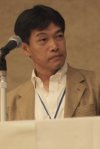 |
 |
|||||||||||||
|
|||||||||||||
|
|||||||||||||
|
"Uchu (宇宙)" is the Japanese word that can be translated as either "universe" or "space." The Advanced Accelerator Association Promoting Science and Technology (AAA) in Japan has been on tour with their symposium series on "uchu" – observing by telescope, exploring by spacecraft and re-creating by accelerator – and the second event was just held in Hiroshima on 4 July. “At Hiroshima University, the observatory dome was built in cooperation with the National Astronomical Observatory of Japan (NAOJ), and the research using the astronomy satellite with the Japan Aerospace Exploration Agency (JAXA) is still ongoing. Of course, together with KEK, we are working towards realising the International Linear Collider. The theme of the symposium fit perfectly to the university's activities”, said Tohru Takahashi of Hiroshima University and one of the organisers for the symposium. “Observing and exploring the universe are subjects which are rather familiar even for a non-scientific audience. We wanted to introduce the ‘re-create’ part, especially to our young audience”, he said. The symposium began with the welcome address by Toshimasa Asahara, the president of Hiroshima University, followed by four lecturers: Hiroaki Aihara from IPMU (Institute for the Physics and Mathematics of the Universe), Masanori Ie from NAOJ, Masanao Abe from JAXA, and Masakazu Yoshioka from KEK. Aihara gave the introduction since IPMU covers all the parts of the research – observing, exploring, re-creating and explaining the history of how human beings are trying to solve the mystery of the universe. Ie then gave a talk on the research activity on the Subaru telescope taking place on the summit of Mauna Kea, a dormant volcano on the Big Island of Hawaii. Subaru has obtained the deepest infrared image of the universe which could promote the study of the origin and evolution of galaxies. He also explained NOAJ's plans to create a 30-metre next-generation infrared telescope, which will come after the Subaru telescope. Abe, a scientist on the Hayabusa space mission, explained the challenge involved in returning a sample of material from a small asteroid called Itokawa. The Hayabusa is on its way home despite loss of communication and fuel leaks. (The communication has been recovered and the disabled ion-engine was re-ignited later). If successful, Hayabusa will be the first spacecraft which was able to bring an asteroid sample to Earth for analysis. Yoshioka started his lecture by explaining what an accelerator is. “When you hear words like ‘telescopes’ or ‘spacecraft’, you have some image in your head. How about when you hear the word ‘accelerators’? Usually you cannot imagine what it looks like only by hearing the name, can you?” asked Yoshioka. He explained Japan's accelerator-related activities such as the KEK B-factory, J-PARC and the test facilities for the ILC. Teppei Suzuki, a seventh-grade student who was one of the youngest attendees in the symposium said, “With my own eyes, I want to see the accelerator which can re-create the big bang. The symposium was very difficult for me, but I want to participate in this kind of symposium again to learn more.” Hiroko Hara, a senior student in high school attended the symposium seeking career guidance. “It was fascinating to hear that the research on small particles and the huge universe are related. I am glad to have a chance to know about respectable research activities by Japanese scientists. Now I feel like I have more choices for my future.” “It is very unusual and meaningful to have a symposium of this kind,” said Masato Arima, AAA's Secretary General. All Japanese laboratories are competitors over the national science budget, and they all have a long wish list of next-generation projects they want to pursue. But, it turned out that the scientists found this kind of opportunity to be very useful in information exchange. “Some lecturers actually first hesitated to participate in the symposium as speakers when we contacted them. But, it turned out that they found this kind of opportunity to be very useful in information exchange”, he said. The next AAA symposium will be held in November at Fukuoka, the most populous city in the southeastern island of Japan. -- Rika Takahashi |
|||||||||||||
| © International Linear Collider |

